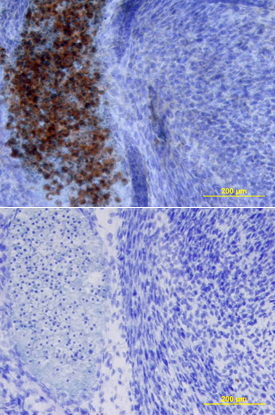Mouse SOST/Sclerostin Biotinylated Antibody Summary
Gln24-Tyr211
Accession # NP_077769
Applications
Please Note: Optimal dilutions should be determined by each laboratory for each application. General Protocols are available in the Technical Information section on our website.
Scientific Data
 View Larger
View Larger
SOST/Sclerostin in Mouse Embryo. SOST/Sclerostin was detected in immersion fixed frozen sections of mouse embryo using Goat Anti-Mouse SOST/Sclerostin Biotinylated Antigen Affinity-purified Polyclonal Antibody (Catalog # BAF1589) at 15 µg/mL overnight at 4 °C. Tissue was stained using the Anti-Goat HRP-DAB Cell & Tissue Staining Kit (brown; Catalog # CTS008) and counterstained with hematoxylin (blue). Lower panel shows a lack of labeling if primary antibodies are omitted and tissue is stained only with secondary antibody followed by incubation with detection reagents. View our protocol for Chromogenic IHC Staining of Frozen Tissue Sections.
Reconstitution Calculator
Preparation and Storage
- 12 months from date of receipt, -20 to -70 °C as supplied.
- 1 month, 2 to 8 °C under sterile conditions after reconstitution.
- 6 months, -20 to -70 °C under sterile conditions after reconstitution.
Background: SOST/Sclerostin
SOST, also known as Sclerostin, is a member of the cerberus/DAN family, a group of secreted glycoproteins characterized by a cysteine-knot motif. Cerberus/DAN family members are putative BMP antagonists, and include Dan, Cerberus, Gremlin, PRDC, and Caronte. While the overall sequence identity between members of the family is low, they have conserved spacing of six cysteine residues. Cerberus and Dan have an additional cysteine residue used for dimerization; however, SOST does not and is secreted as a monomer. SOST was originally identified as an important regulator of bone homeostasis. Positional cloning studies identified that mutations in the SOST gene can cause sclerosteosis and van Buchem disease, bone dysplasia disorders characterized by progressive skeletal overgrowth. Significant levels of SOST expression are detected in bone, cartilage, kidney, and liver. SOST is expressed by osteoclasts in developing bones of mouse embryos, including both intramembranously forming skull bones and endochondrally forming long bones. SOST plays a physiological role as a negative regulator of bone formation by repressing BMP-induced osteogenesis. SOST has been shown to have unique ligand specificity, binding BMP-5, -6, and -7 with high affinity and BMP-2 and -4 with low affinity. This seems to be the first example of a BMP antagonist being localized to osteoclasts, cells derived from the hematopoietic lineage, that function to degrade bone matrix. Recombinant human SOST preparations from R&D Systems bind BMP-5 and BMP-6 in a functional ELISA. Human and mouse SOST share 88% amino acid identity (1‑3).
Product Datasheets
Citations for Mouse SOST/Sclerostin Biotinylated Antibody
R&D Systems personnel manually curate a database that contains references using R&D Systems products. The data collected includes not only links to publications in PubMed, but also provides information about sample types, species, and experimental conditions.
7
Citations: Showing 1 - 7
Filter your results:
Filter by:
-
Exposure of suckling rats to hexavalent chromium (CrVI) alters bone formation at the base of the alveolus causing a delay in tooth eruption
Authors: LM Sánchez, HM Lacave, ÁM Ubios M, CB Bozal
Journal of oral biosciences, 2023-02-21;0(0):.
Species: Rat
Sample Types: Whole Tissue
Applications: IHC -
A FAK/HDAC5 Signaling Axis Controls Osteocyte Mechanotransduction.
Authors: Tadatoshi S, Shiv V, Christian A et al.
Nat Commun.
-
Differential involvement of Wnt signaling in Bmp regulation of cancellous versus periosteal bone growth
Authors: G He, Y Shi, J Lim, T Bellido, J Ni, F Long
Bone Res, 2017-06-06;5(0):17016.
Species: Mouse
Sample Types: Whole Tissue
Applications: IHC -
Immunolocalization of osteocyte-derived molecules during bone fracture healing of mouse ribs
Authors: Z Liu, T Yamamoto, T Hasegawa, H Hongo, K Tsuboi, E Tsuchiya, M Haraguchi, M Abe, PH Freitas, A Kudo, K Oda, M Li, N Amizuka
Biomed Res, 2016-01-01;37(2):141-51.
Species: Mouse
Sample Types: Whole Tissue
Applications: IHC-P -
Loss of Gsalpha in the Postnatal Skeleton Leads to Low Bone Mass and a Blunted Response to Anabolic Parathyroid Hormone Therapy.
Authors: Sinha P, Aarnisalo P, Chubb R, Poulton I, Guo J, Nachtrab G, Kimura T, Swami S, Saeed H, Chen M, Weinstein L, Schipani E, Sims N, Kronenberg H, Wu J
J Biol Chem, 2015-11-23;291(4):1631-42.
Species: Mouse
Sample Types: Whole Tissue
Applications: IHC-P -
The Wnt Inhibitor Sclerostin Is Up-regulated by Mechanical Unloading in Osteocytes in Vitro.
Authors: Spatz J, Wein M, Gooi J, Qu Y, Garr J, Liu S, Barry K, Uda Y, Lai F, Dedic C, Balcells-Camps M, Kronenberg H, Babij P, Pajevic P
J Biol Chem, 2015-05-07;290(27):16744-58.
Species: Mouse
Sample Types: Whole Cells
Applications: IHC -
Gsalpha enhances commitment of mesenchymal progenitors to the osteoblast lineage but restrains osteoblast differentiation in mice.
Authors: Wu JY, Aarnisalo P, Bastepe M, Sinha P, Fulzele K, Selig MK, Chen M, Poulton IJ, Purton LE, Sims NA, Weinstein LS, Kronenberg HM
J. Clin. Invest., 2011-08-01;121(9):3492-504.
Species: Mouse
Sample Types: Whole Tissue
Applications: IHC-P
FAQs
No product specific FAQs exist for this product, however you may
View all Antibody FAQsReviews for Mouse SOST/Sclerostin Biotinylated Antibody
There are currently no reviews for this product. Be the first to review Mouse SOST/Sclerostin Biotinylated Antibody and earn rewards!
Have you used Mouse SOST/Sclerostin Biotinylated Antibody?
Submit a review and receive an Amazon gift card.
$25/€18/£15/$25CAN/¥75 Yuan/¥2500 Yen for a review with an image
$10/€7/£6/$10 CAD/¥70 Yuan/¥1110 Yen for a review without an image

